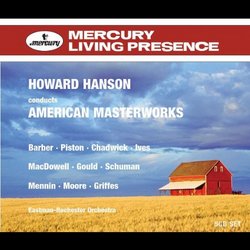| All Artists: Samuel Barber, Walter Piston, Charles Tomlinson Griffes, Kent Kennan, William McCauley, William Bergsma, Charles Ives, William Schuman, Peter Mennin, Morton Gould, George Whitefield Chadwick, Edward MacDowell, Johann Friedrich Peter, Douglas S. Moore, John [Classical] Alden Carpenter, Bernard Rogers, Burrill Phillips, Howard Hanson, Eastman-Rochester Orchestra and Chorus Title: Howard Hanson Conducts American Masterworks Members Wishing: 0 Total Copies: 0 Label: Philips Import Release Date: 9/1/2004 Album Type: Box set, Import Genre: Classical Styles: Ballets & Dances, Ballets, Forms & Genres, Concertos, Historical Periods, Classical (c.1770-1830), Modern, 20th, & 21st Century, Instruments, Reeds & Winds, Symphonies Number of Discs: 5 SwapaCD Credits: 5 UPC: 028947562740 |
Search - Samuel Barber, Walter Piston, Charles Tomlinson Griffes :: Howard Hanson Conducts American Masterworks
 | Samuel Barber, Walter Piston, Charles Tomlinson Griffes Howard Hanson Conducts American Masterworks Genre: Classical |
Larger Image |
CD DetailsSimilar CDs
|
CD ReviewsAn American sampler Larry VanDeSande | Mason, Michigan United States | 06/21/2006 (4 out of 5 stars) "My wife and I often eat at a local restaurant that offers what it calls an "American sampler" of shishkabob, Hawaiian chicken and Louisiana Gulf shrimp. I liken that plate to this collection by the Eastman-Rochester Orchestra and longtime conductor-director Howard Hanson. Based on the quality of much of this music, I think the title could more readily have been "Howard Handson Conducts An American Sampler" rather than American masterworks, for the quality of some of this music is arguable in that respect.
Hanson was not only a composer and conductor, he was a great champion of American music in the 1950s, when its profile and exposure were much less than today. Many of the compositions included in this anthology have since been recorded in DDD in the Maxos American music series. Others have been recorded on other labels in newer, sometimes better, recordings. This does nothing to diminish these recordings or to dampen the memory of Hanson and his band. However, many of the more well known recordings in this set have been re-done either more artistically and/or in better sound since these recordings first appeared the better part of 50 years ago. In particular, Barber's Capricorn Concerto and Medea suite, Ives's Third Symphony & Three Places in New England, Piston's Incredible Flutist and Schuman's New England Triptych have all been recorded many times in the intervening years. The recordings here sometimes magnify the thin and wiry sound coming from the Eastman-Rochester Orchestra. Some are simply not very well played, either. That said, there are still five decade old gems to be located here. Among my favorites are William Bergsma's "Gold and Senor Commandante" ballet suite, a delightful nine-movement ballet suite that is clearly meant for the concert hall and not the stage. I also enjoy Morton Gould's "Sprituals" and George Whitfield Chadwick's "Symphonic Sketches" that merges British stoicism with American melody-making. Best for me is the performance of Peter Mennin's Symphony No. 5. This 1962 recording was probably the first of a Mennin symphony and it still stands up well to competition. The dramatic three movement edifice is completely engaging. Its syncopated rhythm on an ostimato E-F-G-F sharp-A-E theme in the closing movement is catchy and stays long in memory. Another important and rarely recorded piece is Johann Friedrich Peter's "Sinfonia in G". Peter was an early American composer from the Classical period; he was born 1746 and died 1813. The sinfonia mimics the CPE Bach crossover from Baroque to Classical early symphony with modular thematic development in each of its four movements. There are other memorable chunks of Americana on this collection and everything sound wonderful, captured in ultra-clear and well-defined three channel tapes (produced here in stereo and not SACD) from the 1950s and early 1960s. The notes are very helpful and the bookelt details the origin of each recording. There is a very high level of nostalgia evident in this grouping that adds much to its appeal. I think this collection is best suited to people that want to recapture the nostalgia of these great old recordings. Today's DDD technology has nothing on these fine sounding CDs even though Mercury missed an opportunity to release these as three channel SACDs. Perhaps that is coming in the future? Another group of listeners that will most appreciate this collection are people that want exposure to many American composers and don't want to pay a lot to get it. The modest list price for this five CD collection is usually reduced by 40-50 percent when purchasing used from an Amazon vendor. I bought mine for about $20, the cost of less than three new Naxos CDs. This set is certainly worth more than that. Even veteran collectors (who didn't buy the original LPs or individual CDs) will probably find something new and different here." |

